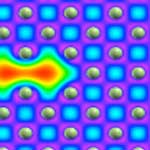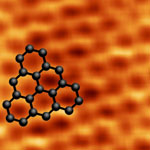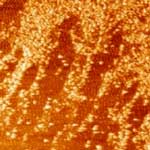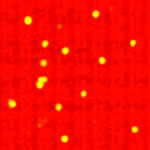Showing Spotlights 1889 - 1896 of 2854 in category All (newest first):
 Why does silicon, which usually shatters catastrophically like glass when fractured, suddenly change and show ductile fracture like metals when the temperature is increased? Large atomistic models that incorporate quantum mechanical effects of how atoms interact in the material have now unravelled the fundamental events that cause the sudden change from brittle cleavage to ductile dislocation emission at a crack tip in silicon. This research has revealed that at low temperatures, silicon fails under spreading of cracks, where atomic bonds are broken continuously such that fractures spread easily in the material. For temperatures beyond a critical point, however, this changes dramatically and rather than breaking atomic bonds, stacked planes of atoms in the silicon lattice are sheared altogether, shutting down the spreading of cracks and giving rise to a much more graceful mode of failure that resembles that of metals.
Why does silicon, which usually shatters catastrophically like glass when fractured, suddenly change and show ductile fracture like metals when the temperature is increased? Large atomistic models that incorporate quantum mechanical effects of how atoms interact in the material have now unravelled the fundamental events that cause the sudden change from brittle cleavage to ductile dislocation emission at a crack tip in silicon. This research has revealed that at low temperatures, silicon fails under spreading of cracks, where atomic bonds are broken continuously such that fractures spread easily in the material. For temperatures beyond a critical point, however, this changes dramatically and rather than breaking atomic bonds, stacked planes of atoms in the silicon lattice are sheared altogether, shutting down the spreading of cracks and giving rise to a much more graceful mode of failure that resembles that of metals.
Jun 22nd, 2010
 In a previous Nanowerk Spotlight we reported about work by a group of Chinese scientists that demonstrated that carbon nanotube sheets can act as powerful thermoacoustic loudspeakers. Moving experiments with carbon nanotube loudspeakers from air into water, researchers at the University of Texas at Dallas have now observed surprisingly high underwater sound generation efficiency using multi-walled carbon nanotubes sheets that are self-supported or attached to porous tissue. As a matter of fact, the nanotechnology speakers perform as well underwater as they do on land. The most surprising result they observed is that the carbon nanotubes immersed in water can still generate sound thermo-acoustically at frequencies 1 Hz - 100 KHz, despite the huge thermal capacity of water and its low thermal expansion.
In a previous Nanowerk Spotlight we reported about work by a group of Chinese scientists that demonstrated that carbon nanotube sheets can act as powerful thermoacoustic loudspeakers. Moving experiments with carbon nanotube loudspeakers from air into water, researchers at the University of Texas at Dallas have now observed surprisingly high underwater sound generation efficiency using multi-walled carbon nanotubes sheets that are self-supported or attached to porous tissue. As a matter of fact, the nanotechnology speakers perform as well underwater as they do on land. The most surprising result they observed is that the carbon nanotubes immersed in water can still generate sound thermo-acoustically at frequencies 1 Hz - 100 KHz, despite the huge thermal capacity of water and its low thermal expansion.
Jun 21st, 2010
 Before the superior electronic properties of graphene can be utilized in industrial products, researchers must find a way that allows the mass production of graphene-based devices. New work by a European research team now demonstrates the feasibility of graphene synthesis on commercially available cubic SiC/Si substrates of 300 mm and greater in diameter, which result in graphene flakes electronically decoupled from the substrate. This work demonstrates that it is possible to grow high-quality graphene layers on beta-SiC(001), i.e. on the cubic modification of this material. This is a very important step, since beta-SiC is commercially available and it can be well integrated into present electronic production processes.
Before the superior electronic properties of graphene can be utilized in industrial products, researchers must find a way that allows the mass production of graphene-based devices. New work by a European research team now demonstrates the feasibility of graphene synthesis on commercially available cubic SiC/Si substrates of 300 mm and greater in diameter, which result in graphene flakes electronically decoupled from the substrate. This work demonstrates that it is possible to grow high-quality graphene layers on beta-SiC(001), i.e. on the cubic modification of this material. This is a very important step, since beta-SiC is commercially available and it can be well integrated into present electronic production processes.
Jun 18th, 2010
 Current fabrication technologies for nanoscale devices include deep-UV or electron-beam (e-beam) lithography. Both of these techniques involve successive deposition of metal or insulating layer and a resist layer, which is patterned using a UV source or a scanning electron beam. The process needs to be repeated for each layer of the architecture while the sample is taken out of the high vacuum chamber. Thus, multilayer lithography processes seriously compromise throughput and cost. In addition, the resolution is limited in the sub-10 nm regime. Researchers at the Institute of Bioengineering and Nanotechnology (IBN) in Singapore have now successfully demonstrated, for the first time, a lithography-free, direct-write technique for fabricating discrete field-effect transistors, as well as digital logic gates on a single nanowire.
Current fabrication technologies for nanoscale devices include deep-UV or electron-beam (e-beam) lithography. Both of these techniques involve successive deposition of metal or insulating layer and a resist layer, which is patterned using a UV source or a scanning electron beam. The process needs to be repeated for each layer of the architecture while the sample is taken out of the high vacuum chamber. Thus, multilayer lithography processes seriously compromise throughput and cost. In addition, the resolution is limited in the sub-10 nm regime. Researchers at the Institute of Bioengineering and Nanotechnology (IBN) in Singapore have now successfully demonstrated, for the first time, a lithography-free, direct-write technique for fabricating discrete field-effect transistors, as well as digital logic gates on a single nanowire.
Jun 16th, 2010
 'You cannot have an appropriate social dialogue on nanotechnology without an open-minded, consistent and even audacious communication roadmap aiming to bring everyone in.' So begins the foreword to a new Communication Roadmap by the European Commission on communicating nanotechnology in Europe. The EC has now compiled a roadmap for communicating nanotechnology across Europe. It presents the focus, objectives, methodology and actions already in place and to be developed over the next few years. The 188-page document is structured into three main parts: Where are we now? Where do we want to be? and How do we get there? and provides a detailed overview of all relevant activities and initiatives existing or planned across Europe.
'You cannot have an appropriate social dialogue on nanotechnology without an open-minded, consistent and even audacious communication roadmap aiming to bring everyone in.' So begins the foreword to a new Communication Roadmap by the European Commission on communicating nanotechnology in Europe. The EC has now compiled a roadmap for communicating nanotechnology across Europe. It presents the focus, objectives, methodology and actions already in place and to be developed over the next few years. The 188-page document is structured into three main parts: Where are we now? Where do we want to be? and How do we get there? and provides a detailed overview of all relevant activities and initiatives existing or planned across Europe.
Jun 14th, 2010
 A U.S.-Japanese research team has now developed methods for synthesizing protein-sized polymer particles with a binding affinity and selectivity comparable to those of natural antibodies by combining molecular imprinting nanoparticle synthesis with a functional monomer optimization strategy. In effect, they have created a plastic antibody, an artificial version of the real thing. They have also demonstrated that it works in the bloodstream of a living animal. As a result, we can now consider synthetic polymer nanoparticles, prepared by an abiotic process in the chemical laboratory, as alternatives to biological macromolecules. Applications could include antidotes for toxins, protein purification and therapies that currently use antibodies.
A U.S.-Japanese research team has now developed methods for synthesizing protein-sized polymer particles with a binding affinity and selectivity comparable to those of natural antibodies by combining molecular imprinting nanoparticle synthesis with a functional monomer optimization strategy. In effect, they have created a plastic antibody, an artificial version of the real thing. They have also demonstrated that it works in the bloodstream of a living animal. As a result, we can now consider synthetic polymer nanoparticles, prepared by an abiotic process in the chemical laboratory, as alternatives to biological macromolecules. Applications could include antidotes for toxins, protein purification and therapies that currently use antibodies.
Jun 11th, 2010
 Nanoparticle chirality has attracted much attention among nanoscientists, and the application of chiral nanoparticles in chemistry, biology and medicine is of great importance for the development of new molecular nanosystems. In chemistry, chirality usually refers to molecules. Discovering efficient methods to produce, control and identify enantiomerically pure chiral compounds is critical for the further development of pharmaceuticals, agrochemicals, fragrances and food additives. An important example in the area of nanomaterials is the synthesis of metallic nanoparticles with controlled size, shape, composition, and morphology for catalytic applications.
Nanoparticle chirality has attracted much attention among nanoscientists, and the application of chiral nanoparticles in chemistry, biology and medicine is of great importance for the development of new molecular nanosystems. In chemistry, chirality usually refers to molecules. Discovering efficient methods to produce, control and identify enantiomerically pure chiral compounds is critical for the further development of pharmaceuticals, agrochemicals, fragrances and food additives. An important example in the area of nanomaterials is the synthesis of metallic nanoparticles with controlled size, shape, composition, and morphology for catalytic applications.
Jun 10th, 2010
 Flame retardant materials have become a major business for the chemical industry and can be found practically everywhere in modern society. Unfortunately, conventional methods for making plastic flame retardant involve a range of often very toxic chemicals. It has already been demonstrated that the flame retardancy of polymeric materials without the use of toxic chemicals could become possible thanks to the synergistic effect of nanoclay and carbon nanotubes. In a step further, researchers have now shown that the use of buckypaper is more efficient as a fire retardant in polymer composites in comparison to directly mixing carbon nanotubes into the composite matrix.
Flame retardant materials have become a major business for the chemical industry and can be found practically everywhere in modern society. Unfortunately, conventional methods for making plastic flame retardant involve a range of often very toxic chemicals. It has already been demonstrated that the flame retardancy of polymeric materials without the use of toxic chemicals could become possible thanks to the synergistic effect of nanoclay and carbon nanotubes. In a step further, researchers have now shown that the use of buckypaper is more efficient as a fire retardant in polymer composites in comparison to directly mixing carbon nanotubes into the composite matrix.
Jun 7th, 2010
 Why does silicon, which usually shatters catastrophically like glass when fractured, suddenly change and show ductile fracture like metals when the temperature is increased? Large atomistic models that incorporate quantum mechanical effects of how atoms interact in the material have now unravelled the fundamental events that cause the sudden change from brittle cleavage to ductile dislocation emission at a crack tip in silicon. This research has revealed that at low temperatures, silicon fails under spreading of cracks, where atomic bonds are broken continuously such that fractures spread easily in the material. For temperatures beyond a critical point, however, this changes dramatically and rather than breaking atomic bonds, stacked planes of atoms in the silicon lattice are sheared altogether, shutting down the spreading of cracks and giving rise to a much more graceful mode of failure that resembles that of metals.
Why does silicon, which usually shatters catastrophically like glass when fractured, suddenly change and show ductile fracture like metals when the temperature is increased? Large atomistic models that incorporate quantum mechanical effects of how atoms interact in the material have now unravelled the fundamental events that cause the sudden change from brittle cleavage to ductile dislocation emission at a crack tip in silicon. This research has revealed that at low temperatures, silicon fails under spreading of cracks, where atomic bonds are broken continuously such that fractures spread easily in the material. For temperatures beyond a critical point, however, this changes dramatically and rather than breaking atomic bonds, stacked planes of atoms in the silicon lattice are sheared altogether, shutting down the spreading of cracks and giving rise to a much more graceful mode of failure that resembles that of metals.
 Subscribe to our Nanotechnology Spotlight feed
Subscribe to our Nanotechnology Spotlight feed





